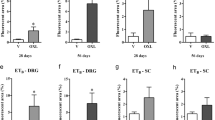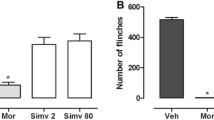Abstract
Since peripheral sensory neuropathy is the major, clinically relevant side effect of sagopilone we investigated the general and peripheral neurotoxicity of sagopilone administered intravenously with different doses (1.2 and 2.4 mg/kg) and schedules in 48 Wistar rats and we performed in parallel a pharmacokinetic/pharmacodynamic (PK/PD) study. A trend toward a different peripheral neurotoxicity could be assessed after 2 weeks of treatment (bolus > 30-min infusion > 3-h infusion) with both doses of sagopilone. Although sagopilone concentrations in peripheral nerve tissue above 100 ng/g were associated with a reduction in nerve conduction velocity (NCV), a clear dose-dependence of this reduction on the level of systemic exposure to sagopilone was not observed. The PK/PD evaluation revealed no consistent effect of the infusion duration on serum PK parameters or the PD read-out NCV. Sagopilone concentrations in brain, sciatic nerve, liver, and kidney were higher after bolus compared to infusion, but there were no influence of infusion duration on these concentrations. No correlation between sagopilone concentrations in any organ/tissue with NCV changes was detected. This study evidences that the PD of sagopilone is not the main determinant of the onset and severity of sagopilone-induced peripheral neurotoxicity in the investigated clinically-relevant dose range, thus indicating that further investigation might identify neuronal-specific mechanisms of action able to drive a focused strategy to prevent peripheral neurotoxicity without reducing the anticancer effectiveness of the epothilones.






Similar content being viewed by others
References
Arnold D, Voigt W, Kiewe P, Behrmann C, Lindemann S, Reif S et al (2009) Weekly administration of sagopilone (ZK-EPO), a fully synthetic epothilone, in patients with refractory solid tumours: results of a phase I trial. Br J Cancer 101:1241–1247
Attard G, Greystoke A, Kaye S, De Bono J (2006) Update on tubulin-binding agents. Pathol Biol (Paris) 54:72–84
Canta A, Chiorazzi A, Cavaletti G (2009) Tubulin: a target for antineoplastic drugs into the cancer cells but also in the peripheral nervous system. Curr Med Chem 16:1315–1324
Canta A, Meregalli C, Chiorazzi A, Carozzi VA, Crippa L, Marmiroli P et al (2010) The ventral caudal nerve: a physiologic-morphometric study in three different rat strains. J Peripher Nerv Syst 15:140–146
Canta A, Chiorazzi A, Carozzi V, Meregalli C, Oggioni N, Sala B et al (2011) In vivo comparative study of the cytotoxicity of a liposomal formulation of cisplatin (lipoplatin). Cancer Chemother Pharmacol 68(4):1001–1008
Cardoso F, de Azambuja E, Lago LD (2008) Current perspectives of epothilones in breast cancer. Eur J Cancer 44:341–352
Cavaletti G, Tredici G, Marmiroli P, Petruccioli MG, Barajon I, Fabbrica D (1992) Morphometric study of the sensory neuron and peripheral nerve changes induced by chronic cisplatin (DDP) administration in rats. Acta Neuropathol (Berl) 84:364–371
Cavaletti G, Minoia C, Schieppati M, Tredici G (1994) Protective effects of glutathione on cisplatin neurotoxicity in rats. Int J Radiat Oncol Biol Phys 29:771–776
Cortes J, Baselga J (2007) Targeting the microtubules in breast cancer beyond taxanes: the epothilones. Oncologist 12:271–280
DeConti RC, Algazi AP, Andrews S, Urbas P, Born O, Stoeckigt D et al (2010) Phase II trial of sagopilone, a novel epothilone analog in metastatic melanoma. Br J Cancer 103:1548–1553
Feyen F, Cachoux F, Gertsch J, Wartmann M, Altmann KH (2008) Epothilones as lead structures for the synthesis-based discovery of new chemotypes for microtubule stabilization. Acc Chem Res 41:21–31
Fornier MN (2007) Ixabepilone, first in a new class of antineoplastic agents: the natural epothilones and their analogues. Clin Breast Cancer 7:757–763
Fumoleau P, Coudert B, Isambert N, Ferrant E (2007) Novel tubulin-targeting agents: anticancer activity and pharmacologic profile of epothilones and related analogues. Ann Oncol 18(Suppl 5):v9–v15
Galmarini CM (2009) Sagopilone, a microtubule stabilizer for the potential treatment of cancer. Curr Opin Investig Drugs 10:1359–1371
Goodin S, Kane MP, Rubin EH (2004) Epothilones: mechanism of action and biologic activity. J Clin Oncol 22:2015–2025
Kolman A (2005) Activity of epothilones. Curr Opin Investig Drugs 6:616–622
Larkin JM, Kaye SB (2006) Epothilones in the treatment of cancer. Expert Opin Investig Drugs 15:691–702
Lee JJ, Swain SM (2008) The epothilones: translating from the laboratory to the clinic. Clin Cancer Res 14:1618–1624
Meregalli C, Canta A, Carozzi VA, Chiorazzi A, Oggioni N, Gilardini A et al (2010) Bortezomib-induced painful neuropathy in rats: a behavioral, neurophysiological and pathological study in rats. Eur J Pain 14:343–350
Morris PG, Fornier MN (2009) Ixabepilone and other epothilones: microtubule-targeting agents for metastatic breast cancer. Clin Adv Hematol Oncol 7:115–122
Morrow PK, Divers S, Provencher L, Luoh SW, Petrella TM, Giurescu M et al (2010) Phase II study evaluating the efficacy and safety of sagopilone (ZK-EPO) in patients with metastatic breast cancer that has progressed following chemotherapy. Breast Cancer Res Treat 123:837–842
Pronzato P (2008) New therapeutic options for chemotherapy-resistant metastatic breast cancer: the epothilones. Drugs 68:139–146
Rustin G, Reed N, Jayson GC, Ledermann JA, Adams M, Perren T et al (2011) A phase II trial evaluating two schedules of sagopilone (ZK-EPO), a novel epothilone, in patients with platinum-resistant ovarian cancer. Ann Oncol 22:2411–2416
Schmid P, Kiewe P, Possinger K, Korfel A, Lindemann S, Giurescu M et al (2010) Phase I study of the novel, fully synthetic epothilone sagopilone (ZK-EPO) in patients with solid tumors. Ann Oncol 21:633–639
Silvani A, Gaviani P, Fiumani A, Scaioli V, Lamperti E, Eoli M et al (2009) Systemic sagopilone (ZK-EPO) treatment of patients with recurrent malignant gliomas. J Neurooncol 95:61–64
Strube A, Suominen MI, Rissanen JP, Mumberg D, Klar U, Halleen JM et al (2011) The anti-tumor agent sagopilone shows antiresorptive effects both in vitro and in vivo. Osteoporos Int 22:2887–2893
Stupp R, Tosoni A, Bromberg JE, Hau P, Campone M, Gijtenbeek J et al (2011) Sagopilone (ZK-EPO, ZK 219477) for recurrent glioblastoma. A phase II multicenter trial by the European Organisation for Research and Treatment of Cancer (EORTC) Brain Tumor Group. Ann Oncol 22:2144–2149
Teicher BA (2008) Newer cytotoxic agents: attacking cancer broadly. Clin Cancer Res 14:1610–1617
Tredici G, Cavaletti G, Petruccioli MG, Fabbrica D, Tedeschi M, Venturino P (1994) Low-dose glutathione administration in the prevention of cisplatin-induced peripheral neuropathy in rats. Neurotoxicology 15:701–704
Trivedi M, Budihardjo I, Loureiro K, Reid TR, Ma JD (2008) Epothilones: a novel class of microtubule-stabilizing drugs for the treatment of cancer. Future Oncol 4:483–500
Acknowledgments
This research has been supported in part by a grant from “Fondazione Banca del Monte di Lombardia”.
Conflict of interest
The authors declare that they have no conflict of interest.
Author information
Authors and Affiliations
Corresponding author
Rights and permissions
About this article
Cite this article
Chiorazzi, A., Höchel, J., Stöckigt, D. et al. Exposure–Response Relationship of the Synthetic Epothilone Sagopilone in a Peripheral Neurotoxicity Rat Model. Neurotox Res 22, 91–101 (2012). https://doi.org/10.1007/s12640-011-9302-7
Received:
Revised:
Accepted:
Published:
Issue Date:
DOI: https://doi.org/10.1007/s12640-011-9302-7




